Tulips are associated with spring and celebrations for most people. They are among the first to bloom after winter. In stores, tulips are often available even out of season.
Typically, flowers are forced in greenhouses in large quantities for holidays, where it's easy to create suitable conditions for the plants. However, tulips can also be grown in pots at home without special equipment. The key is to know the basic agricultural techniques, calculate planting times correctly, and maintain the right temperature regime.
Table of contents
Can You Grow Tulips at Home in a Pot?
Although tulips are not indoor plants, they can be grown on a windowsill or balcony year-round. To produce a large number of flowers for sale, a greenhouse is needed, but a few pots of tulips can easily be grown at home.
Proper preparation of the bulbs and adherence to the temperature regime throughout the growing process are crucial.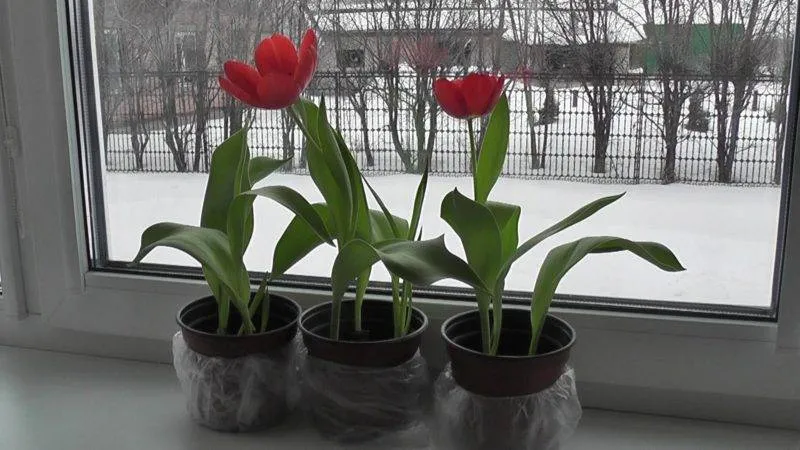
Choosing Suitable Varieties
Not all tulip varieties are suitable for pot cultivation. They must meet several requirements:
- Size. Low-growing or medium-height varieties are best for indoor forcing. Larger specimens will struggle in confined spaces.
- Flowering time. Early-flowering varieties are preferable — they produce buds sooner.
- Characteristics. Simple, double, large- or small-flowered, single- or multi-colored tulips can all be grown on a windowsill. Choose disease- and cold-resistant varieties.
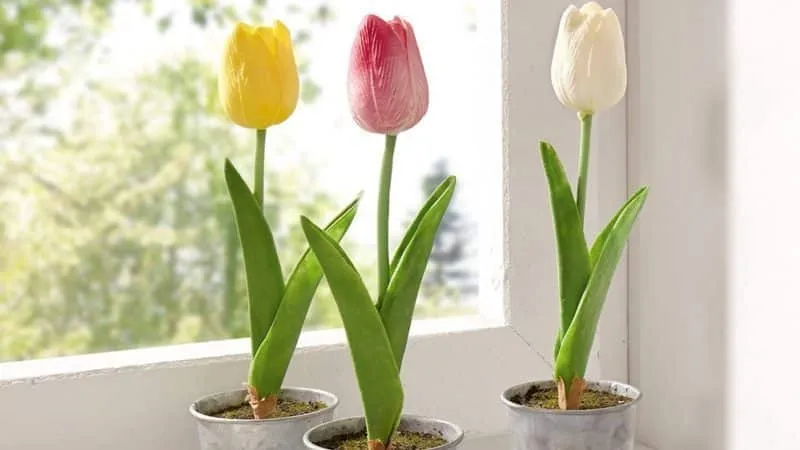
Many varieties are suitable for indoor forcing, including:
- Apricot Beauty;
- Parade Record;
- Miles Bridge;
- Aristocrat;
- Fringed Elegance;
- Negrita;
- Confux;
- Lustige Witwe;
- Christmas Marvel;
- Temple of Beauty;
- Scarborough;
- Eric Hofsjo;
- Apeldoorn;
- London.
These varieties thrive on windowsills in spring, summer, autumn, and winter. They meet all the criteria and are easy to care for.
Note: Exotic varieties with unusual colors (brown, purple, etc.) are not recommended. They require meticulous care and are difficult to grow at home.
Selecting Bulbs
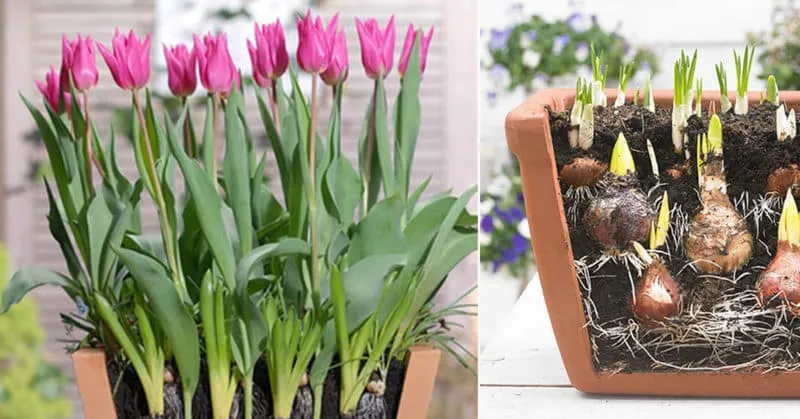
Choosing the right bulbs is as important as selecting the variety. Their quality determines germination and plant health. Look for the following:
- Size. Ideal bulb diameter is 3–4 cm. Smaller bulbs take longer to sprout. Bulblets are unsuitable for forcing.
- Density. Bulbs should feel firm. If juice leaks when pressed, the bulb is spoiled. Suspiciously light weight also indicates poor quality.
- Skin. Brown, not too dark, and elastic. Hard, dense skin suggests over-matured bulbs.
- Appearance. No spots, mold, or signs of infection. The surface should be smooth. Choose round, evenly colored bulbs.
- Base. Firm to the touch, with root bumps visible.
- Stem. Only a small tip should protrude. Check for damage or mold.
These criteria apply to both store-bought and self-collected bulbs. For self-collection:
- Cut blooms immediately after they open.
- Dig up bulbs when stems and leaves turn yellow.
- Fertilize tulips during growth to nourish the bulbs.
Buy bulbs between July and September for the best quality and preparation time.
Optimal Growing Conditions
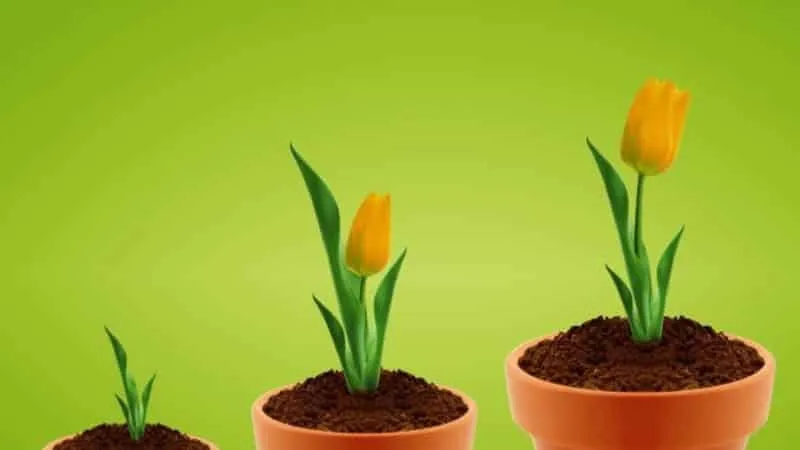
To ensure healthy growth and vibrant blooms, provide the following conditions:
- Temperature. Initially, keep tulips at +7°C. After sprouting, move to +12–18°C. Extreme temperatures affect bloom quality. Significant fluctuations may cause disease.
- Light. If daylight lasts less than 12 hours, use grow lights (preferably full-spectrum). In winter, provide 9 hours of light. Keep bulbs in darkness until sprouts appear. Insufficient light leads to pale flowers.
- Humidity. Maintain 80% humidity. In heated rooms, use a humidifier.
Creating these conditions at home is manageable. While tulips often need extra light, it doesn’t have to be intense.
Tip: If no humidifier is available, place a damp cloth on the radiator and keep it moist.
Choosing a Forcing Location
Windowsills are common, but avoid drafts. If using grow lights, place pots anywhere away from heaters.
A heated, glazed balcony is ideal — natural light may suffice without extra lamps.
Preparation
Before planting, prepare bulbs, soil, and containers. Proper preparation ensures timely blooming.
Bulb Preparation
Start preparing bulbs immediately after purchase or harvest. Follow these steps:
- Sorting. Separate bulbs by size. Larger bulbs sprout faster.
- Temperature adjustment. First, expose bulbs to +30°C, then reduce to +9°C (e.g., in a fridge) until planting.
- Cleaning. Remove husks and check for mold or dark spots.
- Disinfection. Soak bulbs in a light pink potassium permanganate solution for 30 minutes.
Containers and Soil
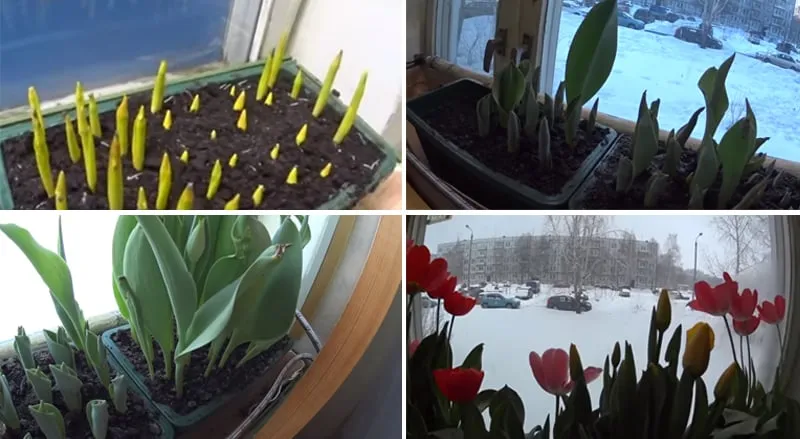
Choose the right container. Plant bulbs close together; container width depends on bulb quantity.
Avoid deep pots: 30 cm depth for large bulbs, 20 cm for small ones.
Ceramic pots are best — they breathe and retain moisture. Plastic lacks these qualities.
Important! Ensure drainage holes in the container base.
Soil options:
- Hydrogel. Retains moisture, ensuring consistent hydration. Comes in colors, attractive in transparent pots. Not cost-effective for commercial growing.
- Sand. Minimizes waterlogging but dries quickly. Requires frequent fertilization.
- Potting mix. Best option. Mix peat, sand, and garden soil in equal parts.
- Water. Possible but increases rot risk.
Disinfect soil and containers with boiling water or potassium permanganate solution.
Planting Time and Technique
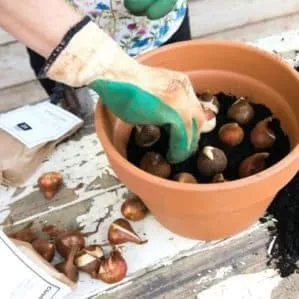
Tulips can be grown indoors year-round. To time blooms correctly, calculate planting dates: 3–4 weeks for rooting, 16–18 weeks from rooting to flowering (for early varieties).
Subtract rooting and growth periods from the desired bloom date. General planting timelines for holidays:
- New Year / Christmas — early September;
- Valentine’s Day — mid-October;
- International Women’s Day — late October / early November.
Potted tulips bloom for over two weeks. Cut flowers last about a week.
Fun fact! Pre-chilled bulbs are sold in stores — plant them immediately.
After preparing bulbs, soil, and containers, proceed with planting:
- Add drainage to the pot. Fill two-thirds with soil.
- Place bulbs 2–3 cm apart (some growers plant them touching). Press lightly into the soil.
- Cover with soil and water with room-temperature water.
Keep at +8–10°C and 75% humidity until sprouts appear. Then reduce to +1–3°C.
Three weeks before flowering, move to a dark room at +14°C. After four days, transfer to a bright spot (or use grow lights) at +18°C.
Ongoing Care
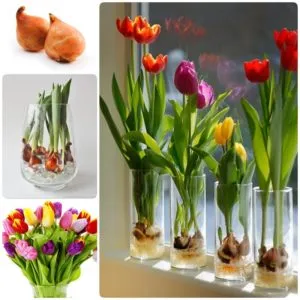
Tulip care is minimal: regular watering and feeding.
Water daily, using cool water (+8–12°C). Avoid wetting leaves or stems.
For the first two weeks, alternate plain water with a calcium nitrate solution (20 g per 10 L water). Fertilize twice with bulb-specific fertilizer (follow instructions).
Avoid over-fertilizing — it damages roots and reduces flowering.
Potential Issues
Diseases are rare if soil, bulbs, and containers were disinfected. Pests are uncommon indoors in winter.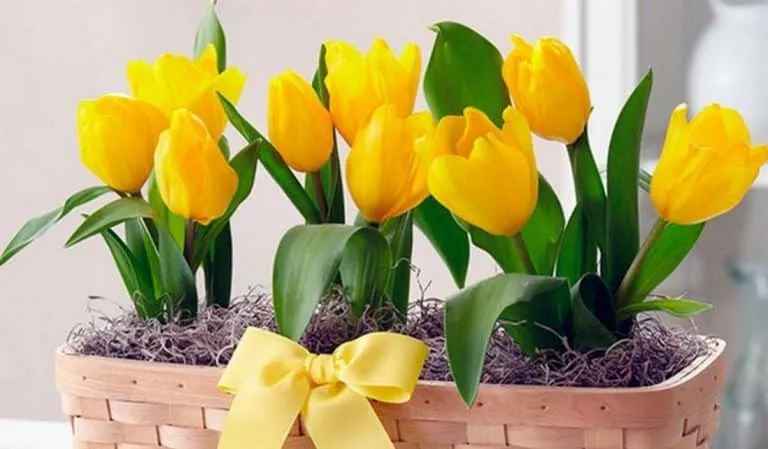
Common beginner mistakes and their effects:
- Dry, papery buds — caused by poor ventilation or excessive heat.
- Drooping stems — temperature too high.
- Weak stems — calcium deficiency.
- Bulbs not rooting — low humidity.
- Rotting bulbs — warm water used for irrigation.
- No flower stems — bulbs too small.
Correcting these issues usually restores healthy growth.
Propagation Methods
The easiest method is bulb division. Mature bulbs produce offsets (bulblets) that can be replanted.
Seed propagation is rare — it takes three years to flower.
Expert Tips
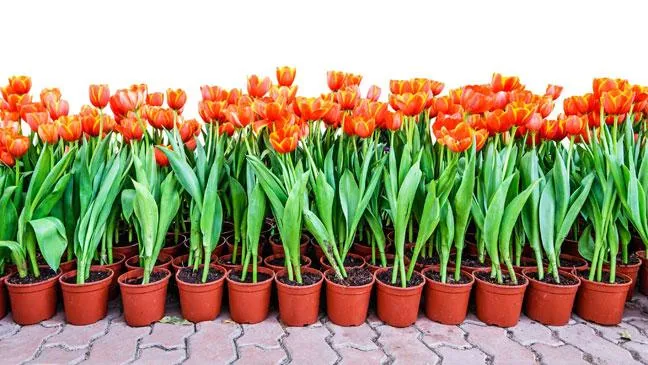
For successful indoor tulip growing:
- To hasten blooming, raise temperature to +20°C and use room-temperature water three days before target bloom time.
- For staggered blooms, plant bulbs in layers — later-blooming varieties deeper.
- Continue care after cutting flowers to harvest quality bulbs for replanting.
Conclusion
Tulips are low-maintenance, requiring only proper watering and feeding.
Provide suitable conditions: keep pots in a basement, balcony, or fridge most of the time. Move indoors three weeks before flowering, ensuring adequate light and humidity.







